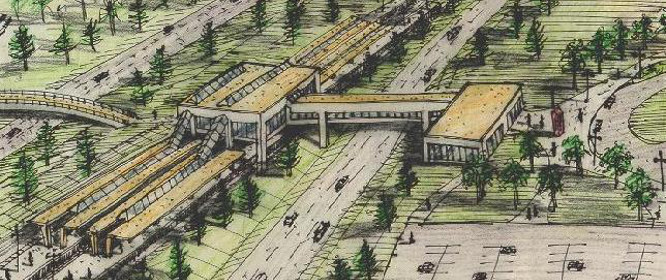One of the biggest layman misconceptions about the link between land use and transportation is that growth creates the same amount of traffic demand no matter where or how it’s located. It was one of the main arguments made against any density increases in Tysons, even those for residential density, because it was inaccurately noted that the increase in population from 17,000 people to 100,000 people would bring the city to a crushing stand still.
It’s not true. This next step in explaining, however, is exactly where planners have gotten communication wrong, the Arlington example. As soon as you say, in Arlington they found… the retort, no matter how valid, will be… “This isn’t Arlington and you need to use suburban ratios”. Back to square one.
Planners need to stop using Arlington as the example. Yes, of course it has nearly doubled its urban core in the past 20 years without any evidence of traffic problems. Yes, the mode share for transit and pedestrians has skyrocketed in Arlington over the last decade.
Absolutely, Arlington is a great model for planners to use for urban revitalization and TOD zoning areas, but when speaking to layman you need to recognize that they see Arlington as a developed city, and the area you are speaking of as a suburban office or industrial park. To them, they can’t see the transition. For them they only see that the metro station currently relies solely on park and ride, and there is no way that putting more housing near it won’t just make it worse.
There are successes of lesser TOD areas, those that are the easiest to see transformations in the three to five year spectrum. West Falls Church, East Falls Church, and Dunn Loring are perfect examples of how, despite hundreds of new dwellings and mixed use projects, the traffic hasn’t resulted in a hellscape.
Those developments, which sell at a premium due to proximity to transit, are (surprise surprise) purchased or rented by people who want to use that transit, and therefore the reliance on cars has lowered quickly. And its a feedback loop, when cars are removed from the roads, we see more non-car infrastructure projects going in, reducing it even further, again despite new development.
If you take a look at all of the urban clusters or TODs in our area, we find that they range from a 60% reduction in per capita vehicular usage, as is the case in Arlington, to a lesser, but still important, 25% reduction in areas like West Falls Church or Dunn Loring.
[baslider name=”TODDensityUsage”]
That might not sound like much, but for Tysons that means around 4,500 residents coming off of local roads and highways on day one, meaning less congestion for vehicle commuters. This also doesn’t include the commuters who will no longer be on Route 7 and 267 by using the Wiehle metro station.
As Tysons develops around the metro stations, the percentage of people travelling by single occupancy will continue to decrease. Even if the percentage were to remain the same as areas like Falls Church, for vehicle count levels to return to what they are currently (prior to metro), Tysons would need to add a population of approximately 6,000 new residents, or 8 new Ascent high-rise sized buildings.
At the same time, with each new building, the percentage of non-SOV users would increase. This would largely occur because new residents would be more inclined to be non-SOV users than existing residents and because new pedestrian improvements would incrementally improve the ability to use non-SOV transportation. The 25% reduction from a standard TOD like Dunn Loring or West Falls Church would be transitioning to a more intense TOD area like Arlington, with 60% reductions.
Incrementally the population would rise to 81,000 new future residents (100,000 total). At that time the city would in fact look like a larger and taller version of current day “downtown” Arlington. Many of the things that make Arlington a walkable urban core would by then be in place, as 81,000 new residents would live in over 90 new high rise buildings (that come with new improvements, new street grids, and new infrastructure upgrades).
The growth in vehicle trips from the 525% increase in population would translate to only a 210% increase in vehicular usage, and that is assuming a conservative current modal share which in reality continues to trend towards greater transit usage each year.
Because the net impact on transportation of a new urban resident would be less than half of a comparable new suburban resident, the tax revenue achieved from the growth would more appropriately address needs. That at its core is the real fiscal beauty for transit oriented development. It provides the ability for regions to continue to grow, but in a way that reduces the cost of that growth.

